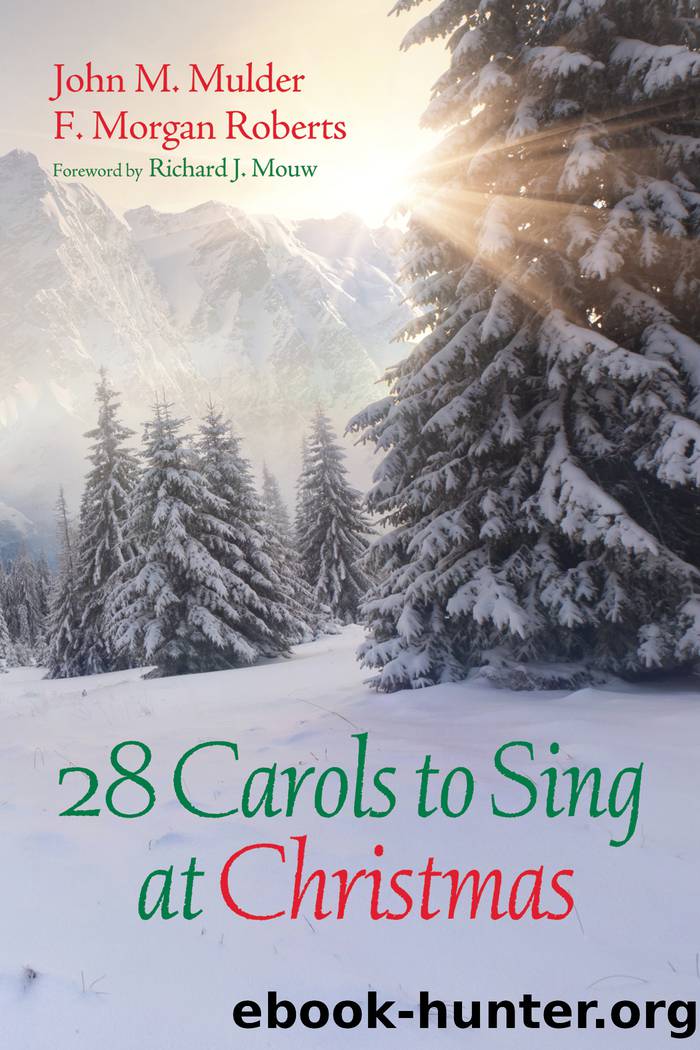28 Carols to Sing at Christmas by Mulder John M.;Roberts F. Morgan;Mouw Richard J.;

Author:Mulder, John M.;Roberts, F. Morgan;Mouw, Richard J.; [Mulder, John M.]
Language: eng
Format: epub
Tags: Religion, General
ISBN: 9781498206839
Publisher: Wipf and Stock Publishers
Published: 2015-10-13T07:00:00+00:00
Let All Mortal Flesh Keep Silence
Let All Mortal Flesh Keep Silence
This hymn was written a long time ago, probably in the fifth century. It comes from Eastern Orthodox Christianity, and it appeared as part of the Liturgy of St. James of Jerusalem. This St. James was one of the twelve apostles and became the first bishop of Jerusalem. He is distinct in the New Testament from James, son of Zebedee, and James (âthe Justâ), the brother of Jesus. Unfortunately for him, he is known as James the Less or Lesser, âthe minor,â âthe little,â or âthe younger.â His father was Alphaeus and his mother was Mary, perhaps a cousin of Mary, the mother of Jesus. Some scholars argue that he was the author of the letter of James.
As with many things in the Bible, experts disagree about all this. What is clear is that the Eastern churches developed differently and eventually separately from those of the Roman Catholic Church (the Western churches) and, of course, Protestantism. The Eastern churches were and still are distinct in church government, theology, and worship.
On Christmas Eve, the Eastern churches use the Liturgy of St. James to celebrate the Last Supper, and the text of âLet All Mortal Flesh Keep Silentâ comes from âThe Prayer of the Cherubic Hymn.â This fifth-century composition was sung as the elements of Communion were brought into the church.
That was 1,600 years ago. Now fast-forward to the nineteenth century. The Reformation represented a decisive break with the Roman Catholic Church, which was already different from Eastern Orthodoxy. The cry of the Reformers was âSola Scriptura!â That meant that if it wasnât in the Bible, it shouldnât be in the church. A fascinating Protestant view of church history emerged: Start with Jesus, jump to the Reformation, and then trace Protestant developments to the present day. It left out all of Eastern Orthodoxy, with its massive influence in the Mediterranean world, Africa, and Asia. It eliminated all of the early and medieval developments of western Christianity.
It reminds me of an old Peanuts cartoon. Linus is sitting at a table, pencil and paper in hand. Charlie Brown asks him, âWhat are you doing?â Linus replies, âIâm writing the history of our church.â Then Linus begins to scrawl, and his first sentence is: âOur pastor was born in 1930.â
That parochialism could not endure forever, but it lasted a very long time. Beginning in the nineteenth century, especially in England, thoughtful pastors and scholars began reclaiming the richness of early and medieval western Christianity and Eastern Orthodoxy, including its worship. It was called the Oxford Movement, and it gained strength and an even broader focus in the twentieth and twenty-first centuries. Today, historians of Christianity agree: the history of the church is the story of world Christianity, including Africa, Asia, and Latin America.
The leaders of the Oxford Movement were skilled in Latin and Greek, and Gerard Moultrie (1829â1855) translated the text of âThe Prayer of the Cherubic Hymnâ from the Greek. His paraphrase was published in Lyra Eucharistica (1864).
Download
This site does not store any files on its server. We only index and link to content provided by other sites. Please contact the content providers to delete copyright contents if any and email us, we'll remove relevant links or contents immediately.
| Catechisms | Devotionals |
| Hymns & Hymnals | Meditations |
| Monasticism & Asceticism | Pentecostal & Charismatic |
| Prayerbooks | Rites & Ceremonies |
| Sacraments |
Fangirl by Rainbow Rowell(8787)
How to Bang a Billionaire by Alexis Hall(7934)
Wonder by R. J. Palacio(7744)
The Space Between by Michelle L. Teichman(6576)
The Thirst by Nesbo Jo(6439)
Assassin’s Fate by Robin Hobb(5855)
Wiseguy by Nicholas Pileggi(5319)
The Night Circus by Erin Morgenstern(5040)
The Kite Runner by Khaled Hosseini(4952)
Paper Towns by Green John(4800)
Bittersweet (True North #1) by Sarina Bowen(4717)
Gerald's Game by Stephen King(4376)
Too Much and Not the Mood by Durga Chew-Bose(4095)
Pillow Thoughts by Courtney Peppernell(4011)
Goodbye Paradise(3446)
Twelve Days of Christmas by Debbie Macomber(3412)
Good by S. Walden(3347)
The Rosie Effect by Graeme Simsion(3209)
The Cellar by Natasha Preston(3077)
